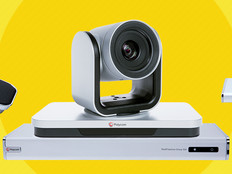4 Building Blocks of a Successful Digital-Signage Implementation
With all the attention focused on the web the past few years, it’s easy to lose sight of how effectively technology can be applied in the brick-and-mortar world. Digital signage provides ample evidence that technology can do a lot more than just deliver information to desktop browsers and smartphones. It can also deliver the right message at the right time.
In hospitals, for instance, patients can navigate touch-screen displays for wayfinding purposes or for looking up clinic schedules and directory information. But healthcare organizations that want to bring digital signage to their campuses need to first select the right components and put them together in the right configuration. These components include:
1. Content Management Systems
At the head of any digital-signage implementation is the system by which display content is managed. Management can range from ad hoc updates of simple text to complex, scheduled rotations of rich video and audio content. The most important consideration for these systems is that they provide the required management functionality via a reasonably intuitive user interface.
2. Digital Display Devices
At the delivery end of any digital-signage implementation are the displays themselves. Displays can vary substantially in size, image quality, cost and useful life span. Plasma screens, for example, offer excellent image quality, as well as the ability to view images from a range of angles. Plasma’s strong contrast and rich color saturation make it particularly appropriate for spaces with a lot of ambient light. LCDs, on the other hand, may not offer as broad a viewing angle as plasma screens, but they consume less energy and can last twice as long.
By using multiple, modular, thin-bezeled displays coordinated through a matrix controller, digital-signage professionals can even build entire video walls. In combination with a high-quality speaker system, this setup can dramatically transform an otherwise static space into a dynamic, immersive experience of sound and light.
3. Media Players
To display multimedia content, a digital-signage implementation usually requires one or more devices to play the content — sort of a minicomputer dedicated to audio and video playback. These devices are often Windows-based systems with sufficient storage capacity and processor speed to handle large multimedia files. They can be hung behind the displays or housed in an equipment closet and attached to the displays via wired or wireless networks.
The choice of media player will depend on the type of content displayed, as well as the size and number of different content packages that must be stored for possible future display needs. Some of today’s more advanced media players are fanless (therefore, quiet) and use solid-state storage (with fewer moving parts that could fail).
4. Signage Connectivity
Depending on the nature of the implementation, it is also important to properly design and install an infrastructure that will distribute content to the various digital-display devices. In addition to typical network cabling and switching, it may be necessary to use extenders and splitters to maintain signal quality and distribute images to multiple screens. These considerations become even more critical for implementations where there are significant distances between displays or where signage in multiple locations must be managed centrally.
Bringing It All Together
The components outlined above are available from a variety of top-tier vendors. These vendors also offer a selection of other components for building a complete digital-signage network, ranging from the basic hardware for mounting digital displays to sophisticated signal management solutions that allow images on multiple screens to be coordinated with a high degree of precision.
Of course, there’s one more component that’s essential for any successful digital-signage implementation: imagination. Someone has to look at a space where there is no digital signage today and imagine how digital signage could enhance it with eye-catching, real-time communications.
Vendors can supply some of this, too, through consulting services or creative templates. But ultimately, it takes a leader with vision inside an organization to imagine how digital signage can help accomplish objectives — and then champion that idea from conception to implementation.
Dive Deeper
Wondering how to effectively implement digital signage and other technologies at your facility? Download the white paper “Visual Solutions: Seeing Is Achieving” to learn more about the:
- Power of audio/visual presentation tools
- Primary motivating factors in the broad adoption of visual solutions
- Reasons for finding a partner that supports the organization’s move to better visual communication
You'll also score access to HealthTech's entire library of free, downloadable white papers by signing up just once.







